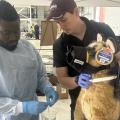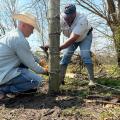Questions following a hurricane
Was the desiccation of cotton leaves due to the salt content in the hurricane?
This has been a common misconception. Many cotton fields across the state have desiccated leaves similar to symptoms from an application of Sodium Chlorate. However, most of this is in the mature cotton leaves that have already started producing ethylene and abscisic acid. Ethylene and abscisic acid are hormones that accelerate senescence and leaf abscission. When the cotton plant is injured in any way, in this case 50 - 70 mph winds, these hormones are rapidly increased in the plant. This causes the leaves to increase the senescence process and begin to dry up. This coupled with the high winds for extended periods of time have left us with the "Sodium Chlorate" effect on the leaf tissue.
Winds have knocked off most of the leaves on my crop. Should I go ahead and defoliate or wait?
If your cotton crop is ready to defoliate (at least 60% open, and top harvestable boll is mature) then yes, you should begin defoliation. However, if your fields are only 30-40% open, defoliating will most likely lead to decreased yield and fiber quality, particularly length. Even though most of the leaves may be gone, cotton has a tremendous ability to compensate and may transport needed nutrients to immature bolls. Leaves will also re-grow in an attempt to compensate. Within 7-10 days, if the crop is not recovering, you will know because the bolls will begin to open very quickly.
Will my cotton stand back up?
In most cases the cotton will straighten up if not but just a little bit. This is especially true when the cotton is defoliated where the leaves have it tangled up. In many cases, where the cotton was rank and the top crop was heavy, it may take a little longer. However in years past when we have experienced high winds, the cotton has always made an attempt to stand back up.
How much boll rot and hard-lock can we expect?
If the cotton bolls are lying on the ground, there is a pretty good probability that they will rot. The bolls that were beginning to crack when the storm hit stand a pretty good probability of hard-locking. Overall we shouldn't see more than a boll or two that will rot or hard-lock per plant. The fact that the wind took many leaves off will help to alleviate the rot problems.
Publications
News
FLOWOOD, Miss. -- When responding to emergencies, collaboration between state agencies is critical in the effort to save lives.
EGYPT, Miss. -- On hot days, Robert Thompson’s beef cows used to retreat to a cluster of trees in the middle of his pasture for shade.
STARKVILLE, Miss. -- After natural disasters, food and shelter are prioritized well above mental health, but ignoring emotional distress can lead to serious physical health conditions.







